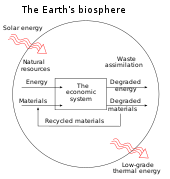
Back Termo iqtisadiyyat Azerbaijani তাপীয় অর্থনীতি শাস্ত্র Bengali/Bangla Termoeconomía Spanish ترمواکونومیک Persian ऊष्मा-अर्थशास्त्र Hindi Թերմոէկոնոմիկա Armenian Termoeconomia Italian Termoeconomia Portuguese Entropie economică Romanian Термоекономіка Ukrainian
| Part of a series on |
| Ecological economics |
|---|
 |
This article may be too technical for most readers to understand. (May 2022) |
Thermoeconomics, also referred to as biophysical economics, is a school of heterodox economics that applies the laws of statistical mechanics to economic theory.[1] Thermoeconomics can be thought of as the statistical physics of economic value[2] and is a subfield of econophysics.
It is the study of the ways and means by which human societies procure and use energy and other biological and physical resources to produce, distribute, consume and exchange goods and services, while generating various types of waste and environmental impacts. Biophysical economics builds on both social sciences and natural sciences to overcome some of the most fundamental limitations and blind spots of conventional economics. It makes it possible to understand some key requirements and framework conditions for economic growth, as well as related constraints and boundaries.[3]
- ^ Sieniutycz, Stanislaw; Salamon, Peter (1990). Finite-Time Thermodynamics and Thermoeconomics. Taylor & Francis. ISBN 0-8448-1668-X.
- ^ Chen, Jing (2005). The Physical Foundation of Economics - an Analytical Thermodynamic Theory. World Scientific. ISBN 981-256-323-7.
- ^ "What is biophysical economics?". BiophysEco. 2017-01-23. Retrieved 2022-09-28.